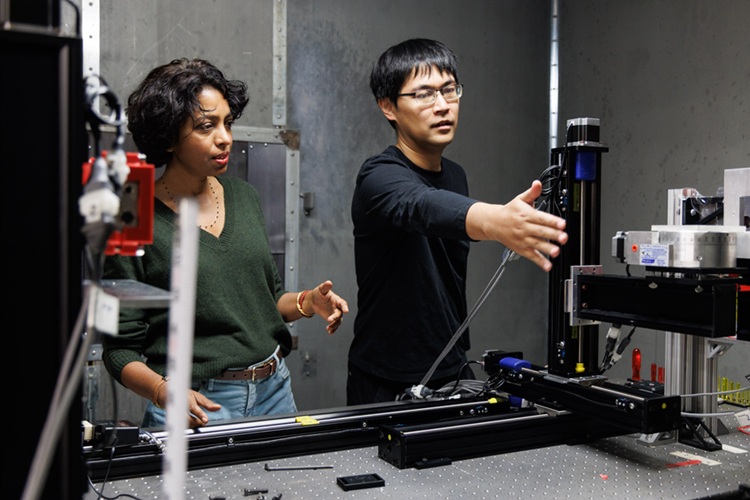Global Medical Flat Panel Detector (FPD) Market Sees Increasing Adoption of Wireless Flat Panel Technology
|
By MedImaging International staff writers Posted on 14 Mar 2022 |

The global medical flat panel detector (FPD) market recorded an increase of 4% in unit sales in 2020 to reach a market size of just under 70,000 units, although revenues declined by almost 10% to USD 2.1 billion. The market fluctuations were similar to those witnessed in the X-ray modality markets, with static FPDs used primarily in fixed digital radiography (DR) rooms and mobile DR registering a 10% year-on-year growth. The growth was driven purchases of mobile X-ray systems for diagnosis of pneumonia as an indicator of COVID-19 by healthcare providers across the world. Conversely, the market for dynamic panels, often used for fluoroscopy, surgical and interventional procedures, fell sharply with units down 18% from 2019 to 2020 as elective surgeries were postponed or cancelled.
These are the latest findings of Signify Research (Cranfield, UK), an independent supplier of market intelligence and consultancy to the global healthcare technology industry. Signify predicts the medical FPD market to reach 85,000 units by 2025. However, as average selling prices are expected to continue to fall, market revenues are projected to decline. In 2021, there was a shift in market dynamics with the demand for static panels used in mobile radiography declining, as the surplus demand in 2020 had been met during the initial waves of the pandemic. However, as elective procedures commenced once again in 2021, the demand for dynamic panels for mobile C-arm and interventional applications increased. In 2021, unit sales of dynamic panel increased by just under 15%, almost returning to pre-pandemic levels, according to Signify.
The demand for wireless technology continues to increase in applications such as fixed and mobile radiography, especially in the developed markets where benefits such as increased workflow capabilities are widely recognized. The share of wireless detectors in all FPD unit sales stood at 53% in 2020 which Signify forecasts to grow to 61% by 2025. Physical parameters such as detector weight, extended battery life, and liquid damage protection also play a role in the purchasing process, although these factors are typically a lower priority than image quality and dose reduction. Purchasers are also paying attention to the pixel resolution and detective quantum efficiency (DQE). Manufacturers of FPDs are developing thicker scintillator layers and increasing the DQE level possible with their detectors.
Suppliers of FPDs are developing new products that have reduced scatter, lower noise, higher resolution and require lower dose exposure, a key consideration for healthcare providers and increasingly for patients as well. A combination of these features can reduce the need for retakes and increases clinical precision, enabling imaging departments to perform more efficiently. Another key consideration when purchasing FPDs is the reliability and durability of the panel. Providers are demanding more robust, reliable panels, with a greater return on investment before replacement is required. As a result of this, providers are requesting service contracts or extended warranties to support increasing the lifespan of the detectors.
Cesium iodide is the gold standard for medical imaging FPDs, but limited demand for gadolinium oxysulfide (Gadox) panels remains. Cesium iodide panels are more sensitive and produce higher quality images than Gadox equivalents, but come with a higher associated cost. The focus on reducing radiation dose in Western Europe and North America is limiting the demand for Gadox panels. However, they continue to be sold in some price sensitive markets across Latin America. Signify expects the demand for Gadox detectors to decline throughout the forecast period to 2025. As the prices of cesium iodide panels become more affordable, these panels are becoming more accessible to a wider range of customers. In addition, further acknowledgement of the dose optimization benefits of cesium iodide FPDs in the emerging countries will drive the adoption of this panel type. Signify anticipates the demand for Gadox panels to be maintained beyond the forecast period by smaller clinics and independent medical imaging facilities where cost is the primary consideration.
The medical FPD market remains highly fragmented and competitive, with 15 vendors having at least a 2% market share each. Chinese FPD vendors gained market share in 2020, due to increased production and surplus inventory for supply to mobile X-ray system manufacturers. Chinese FPD companies continue to drive an aggressive price war, forcing international FPD vendors to re-evaluate supply chains and open production facilities in lower cost countries such as China. In the coming years, Signify expects the developing markets, such as Latin America, Africa and parts of Asia, to provide a key growth opportunity for vendors with cost-efficient FPDs. With most countries in these regions having large installed bases of analogue or computed radiography systems, Signify expects continued digitalization as the affordability of digital X-ray systems continues to increase.
As the low-end FPD market continues to become saturated and the price war continues, with newer Asian FPD vendors increasing market presence globally, Signify expects the margins for FPD vendors to be increasingly at stake. After years of double-digit price erosion, Signify expects medical FPD prices to stabilize with only single-digit price annual declines through to 2025. As a result, FPD vendors are progressively investing in research and development to upgrade their product lines to showcase latest hardware innovation and establish a niche. Such developments include IGZO, flexible detectors, photon counting and addition of AEC chambers on the detectors themselves. The target markets for these higher-end FPD products include developed countries and high-end hospitals where clinical precision is still paramount.
Related Links:
Signify Research
Latest Industry News News
- GE HealthCare and NVIDIA Collaboration to Reimagine Diagnostic Imaging
- Patient-Specific 3D-Printed Phantoms Transform CT Imaging
- Siemens and Sectra Collaborate on Enhancing Radiology Workflows
- Bracco Diagnostics and ColoWatch Partner to Expand Availability CRC Screening Tests Using Virtual Colonoscopy
- Mindray Partners with TeleRay to Streamline Ultrasound Delivery
- Philips and Medtronic Partner on Stroke Care
- Siemens and Medtronic Enter into Global Partnership for Advancing Spine Care Imaging Technologies
- RSNA 2024 Technical Exhibits to Showcase Latest Advances in Radiology
- Bracco Collaborates with Arrayus on Microbubble-Assisted Focused Ultrasound Therapy for Pancreatic Cancer
- Innovative Collaboration to Enhance Ischemic Stroke Detection and Elevate Standards in Diagnostic Imaging
- RSNA 2024 Registration Opens
- Microsoft collaborates with Leading Academic Medical Systems to Advance AI in Medical Imaging
- GE HealthCare Acquires Intelligent Ultrasound Group’s Clinical Artificial Intelligence Business
- Bayer and Rad AI Collaborate on Expanding Use of Cutting Edge AI Radiology Operational Solutions
- Polish Med-Tech Company BrainScan to Expand Extensively into Foreign Markets
- Hologic Acquires UK-Based Breast Surgical Guidance Company Endomagnetics Ltd.
Channels
Radiography
view channel
X-Ray Breakthrough Captures Three Image-Contrast Types in Single Shot
Detecting early-stage cancer or subtle changes deep inside tissues has long challenged conventional X-ray systems, which rely only on how structures absorb radiation. This limitation keeps many microstructural... Read more
AI Generates Future Knee X-Rays to Predict Osteoarthritis Progression Risk
Osteoarthritis, a degenerative joint disease affecting over 500 million people worldwide, is the leading cause of disability among older adults. Current diagnostic tools allow doctors to assess damage... Read moreMRI
view channel
Novel Imaging Approach to Improve Treatment for Spinal Cord Injuries
Vascular dysfunction in the spinal cord contributes to multiple neurological conditions, including traumatic injuries and degenerative cervical myelopathy, where reduced blood flow can lead to progressive... Read more
AI-Assisted Model Enhances MRI Heart Scans
A cardiac MRI can reveal critical information about the heart’s function and any abnormalities, but traditional scans take 30 to 90 minutes and often suffer from poor image quality due to patient movement.... Read more
AI Model Outperforms Doctors at Identifying Patients Most At-Risk of Cardiac Arrest
Hypertrophic cardiomyopathy is one of the most common inherited heart conditions and a leading cause of sudden cardiac death in young individuals and athletes. While many patients live normal lives, some... Read moreUltrasound
view channel
Wearable Ultrasound Imaging System to Enable Real-Time Disease Monitoring
Chronic conditions such as hypertension and heart failure require close monitoring, yet today’s ultrasound imaging is largely confined to hospitals and short, episodic scans. This reactive model limits... Read more
Ultrasound Technique Visualizes Deep Blood Vessels in 3D Without Contrast Agents
Producing clear 3D images of deep blood vessels has long been difficult without relying on contrast agents, CT scans, or MRI. Standard ultrasound typically provides only 2D cross-sections, limiting clinicians’... Read moreNuclear Medicine
view channel
PET Imaging of Inflammation Predicts Recovery and Guides Therapy After Heart Attack
Acute myocardial infarction can trigger lasting heart damage, yet clinicians still lack reliable tools to identify which patients will regain function and which may develop heart failure.... Read more
Radiotheranostic Approach Detects, Kills and Reprograms Aggressive Cancers
Aggressive cancers such as osteosarcoma and glioblastoma often resist standard therapies, thrive in hostile tumor environments, and recur despite surgery, radiation, or chemotherapy. These tumors also... Read more
New Imaging Solution Improves Survival for Patients with Recurring Prostate Cancer
Detecting recurrent prostate cancer remains one of the most difficult challenges in oncology, as standard imaging methods such as bone scans and CT scans often fail to accurately locate small or early-stage tumors.... Read moreGeneral/Advanced Imaging
view channel
3D Scanning Approach Enables Ultra-Precise Brain Surgery
Precise navigation is critical in neurosurgery, yet even small alignment errors can affect outcomes when operating deep within the brain. A new 3D surface-scanning approach now provides a radiation-free... Read more
AI Tool Improves Medical Imaging Process by 90%
Accurately labeling different regions within medical scans, a process known as medical image segmentation, is critical for diagnosis, surgery planning, and research. Traditionally, this has been a manual... Read more
New Ultrasmall, Light-Sensitive Nanoparticles Could Serve as Contrast Agents
Medical imaging technologies face ongoing challenges in capturing accurate, detailed views of internal processes, especially in conditions like cancer, where tracking disease development and treatment... Read more
AI Algorithm Accurately Predicts Pancreatic Cancer Metastasis Using Routine CT Images
In pancreatic cancer, detecting whether the disease has spread to other organs is critical for determining whether surgery is appropriate. If metastasis is present, surgery is not recommended, yet current... Read moreImaging IT
view channel
New Google Cloud Medical Imaging Suite Makes Imaging Healthcare Data More Accessible
Medical imaging is a critical tool used to diagnose patients, and there are billions of medical images scanned globally each year. Imaging data accounts for about 90% of all healthcare data1 and, until... Read more



















